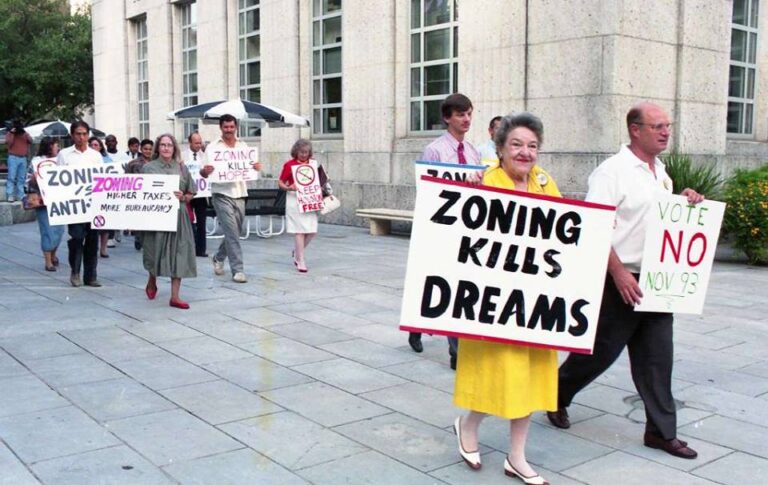Physical Address
304 North Cardinal St.
Dorchester Center, MA 02124
Physical Address
304 North Cardinal St.
Dorchester Center, MA 02124

1. This week at Market Urbansim: ‘Who better to determine local needs than property owners and concerned citizens themselves?’ by Michael Hamilton Instead, land-use regulations can, and often are, used as cudgels against disfavored groups or individuals. Issues of personal taste—yard size, material choices, building design, amount of parking—can be weaponized when turned into regulatory requirements and greatly decrease a plot of land’s value. Donald Shoup Takes San Francisco by Sandy ikeda As I said before, to do market pricing correctly, well, you need markets. What the San Francisco approach does is to try to mimic what it is thought a private market would do. But the standard of “at least one empty parking spot” is arbitrary – like mandating that every ice-cream cone have two and only two scoops of ice cream. The Shoup-inspired San Francisco solution is I think a step in the right direction, but only a step. Episode 05 of the Market Urbanism Podcast with Nolan Gray: Samuel Zipp and Nathan Storring on Vital Little Plans This week on the Market Urbanism Podcast, I chat with Samuel Zipp and Nathan Storring on the wonderful new volume Vital Little Plans: The Short Works of Jane Jacobs. From Jacobs’ McCarthy-era defense of unorthodox thinking to snippets of her unpublished history of humanity, the book is a must-read for fans of Jane Jacobs. In this podcast, we discuss some of the broader themes of Jacobs’ thinking America’s Progressive Developers–Silver Ventures by Scott Beyer Foremost among these is the Pearl Brewery, a 22-acre former industrial site that is north of downtown. “The Pearl” is now viewed by locals as San Antonio’s leading urbanist destination—as opposed to the touristy downtown—but it wasn’t always this way. 2. Where’s Scott? Scott Beyer spent week 4 in San Diego. His Forbes article was about […]

Every so often during his tenure as mayor of New York, Michael Bloomberg tried to push through congestion pricing, in which drivers would have to pay to use city streets in Midtown and Lower Manhattan. That’s a popular solution to chronic overcrowding but, like drinking coffee to try to cure a hang over, it doesn’t really get to the heart of the matter. More intervention usually doesn’t solve the problems that were themselves the result of a prior intervention. Let me explain. In 2011, I had the opportunity to participate in an online discussion over at Cato Unbound. It focused on Donald Shoup’s book The High Cost of Free Parking, which looks at the consequences of not charging for curbside parking. If you’ve ever tried to find a parking spot on the street in a big city, especially on weekdays, you know how irritating and time-consuming it can be. It may not top your list of major social problems, except perhaps when you’re actually trying to do it. In fact, according to Shoup about 30 percent of all cars in congested traffic are just looking for a place to park. The problem though is not so much that there are too many cars, but that street parking is “free.” Except, of course, it isn’t free. What people mean when they say that some scarce commodity is free is that it’s priced at zero. Some cities, such as London, Mayor Bloomberg’s inspiration, charge for entering certain zones during business hours — with some success. (As well as unintended consequences: People living in priced zones pay much less for parking and higher demand has driven central London’s real-estate prices, already sky high, even higher). But this doesn’t really address what may be the main source of the problem: the price doesn’t […]

The Cato Institute’s Vanessa Brown Calder is skeptical of the Obama administration’s suggestion that state governments can play a role in liberalizing land-use regulation, a policy area usually dominated by local governments. In an otherwise thoughtful post responding to a variety of proposals, she writes that federal and state-level bureaucrats should step aside to allow local advocacy groups to fill the void. She asks, “Who better to determine local needs than property owners and concerned citizens themselves?” Pretty much anyone, really. Local control of land-use regulation is a mistake and concerned citizens in particular are ill-suited for making decisions about their neighbors’ property. Supporters of free societies usually oppose local control of basic rights for good reason. Exercising one’s rights can be inconvenient for or offensive to nearby third parties. Protesters slow traffic, writers blaspheme, rock bands use foul words, post-apartheid blacks live wherever they choose with no regard for long-held South African social conventions, and so on. These inconveniences obviously don’t override rights to freedom of expression, but lower levels of government might be persuaded by people whose sensibilities are offended by these expressions. People are more likely to favor restrictions on rights when presented with a specific situation than they are when asked about general principles. People are even more likely to favor restricting a specific, disliked person’s rights. The landmark First Amendment case, National Socialist Party of America v. Village of Skokie, is instructive. The plaintiffs, American Nazis planning a parade through a neighborhood populated by Holocaust survivors in Illinois, sued on First Amendment grounds when the local government tried to prevent them from carrying swastikas. The Supreme Court eventually ruled in favor of the Nazis because the First Amendment protects peaceful demonstrations with no regard for the vile or hateful content of the ideas being promoted […]

1. This week at Market Urbansim: Markets As Cities by Sandy Ikeda There is a deep affinity between cities and markets, and indeed between cities and liberty. (As the old saying goes, “City air makes you free.”) Cities aren’t merely convenient locations for markets; a living city (which I’ll define in a moment) is a market. MU Podcast Episode 04: Anthony Ling on Brazilian Cities and the Future of Transportation Anthony is founder and editor of Caos Planejado, a Brazilian website on cities and urban planning. He also founded Bora, a transportation technology startup and is currently an MBA candidate at Stanford University. He graduated Architecture and Urban Planning at Universidade Federal do Rio Grande do Sul. 2. Where’s Scott? Scott Beyer spent his second week in San Diego, and this weekend is visiting Corona Del Mar in Orange County, where he’ll get a driving tour from some MU enthusiasts. His Forbes articles this week were America’s 20 Largest Metros Have Higher GDPs Than Most Foreign Nations and Austin’s Rail Transit Boondoggle, Further Explained Agencies like Austin’s CapMetro are dogmatic and unimaginative. They observe a top-down solution, such as rail transit, that may work in a few U.S. cities; they take the plan off the shelf and plop it into their own city, regardless of whether or not it fits; then, when the project fails miserably–as it has in many cities–they send out their press team to justify it, using every crackpot methodology. Scott will be returning November 9 to San Antonio to give a speech on the city’s economic emergence. Here’s a write-up about the event by the San Antonio Business Journal. 3. At the Market Urbanism Facebook Group: Louise Ortensia asks “Capitalism for urbanists? Pretty redundant, isn’t it?” An interesting dialogue ensues… David Welton asks “has anyone here contacted local politicians in […]

1. This week at Market Urbanism: 4 Things Austin’s City Council Could Do Today To Fight The Housing Shortage by Dan Keshet Central Austin needs more housing. Prices have been rising, more and more people want to live where they have short commutes, but are only able to afford homes near the periphery. We have a long-term plan to alter our land development code in a way that would help…but our need is now. What options are available today? Spillovers: Knowledge, Beer, and Technology by Sandy Ikeda I don’t think anyone could reasonably contest that technology has reduced the need for some kinds of proximity. It’s the tired hyperbole that “science obliterates distance” and the like that gets my goat. The gulf between “reducing” and “eliminating” is too vast. Where Do Upzonings Happen? by Chris Bradford What NIMBYs are really after is limiting access to neighborhood amenities, mostly by limiting the quantity of housing. Neighborhoods (at least the ones empowered politically) do their best to hold housing below the market-clearing quantity. Book Review: The Well-Tempered City by Emily Hamilton a review of a book by Jonathan F. P. Rose In the vein of Jane Jacobs and F.A. Hayek, Rose identifies that cities are “wicked” problems rather than engineering problems that policymakers can solve through tinkering. In spite of this recognition of the complexity of cities’ interrelated systems, Rose asserts that cities need visionaries to address problems from obesity to climate change from the top down. 2. Where’s Scott? Scott Beyer has changed his schedule. He thought San Diego would be a pass-through stop this week on the way to Los Angeles. But he found “America’s Finest City” surprisingly dense, and decided to stay all of October. His two Forbes articles this week were about The Millennials Transforming San Antonio and […]

I think the most useful way to think about NIMBYism is as a neighborhood-centered phenomenon. When people shop for homes, they shop for specific, physical features of a dwelling, of course, but mainly they shop for neighborhoods. The quality of neighborhood amenities — interpreted broadly to include things like school quality and access to the CBD — varies wildly from neighborhood to neighborhood, and thus does the amount people are willing to pay for those amenities. What NIMBYs are really after is limiting access to neighborhood amenities, mostly by limiting the quantity of housing. Neighborhoods (at least the ones empowered politically) do their best to hold housing below the market-clearing quantity. This ensures that the value of neighborhood amenities is capitalized into home prices. Without quantity controls, the “nicest” neighborhoods would be the densest. Instead, thanks to zoning, they’re simply the most expensive. There’s a steep premium for buying into the neighborhood club. Here’s evidence in favor of the “club” theory from L.A. planner C.J. Gabbe. (H/t Urbanize.LA.) Gabbe asks the question, “Where do upzonings and downzonings happen?” To answer it, he looked at how the zoning of each of L.A.’s 780,000 parcels changed between 2002 and 2014, and tallied whether a lot was “upzoned” or “downzoned”, as measured by the change in allowed residential density. The first striking result was how few of the parcels were either upzoned or downzoned: an average of just 225 acres were upzoned and 216 acres downzoned annually between 2002 and 2014. That is, less than two-tenths of one percent of L.A.’s land area was upzoned or downzoned each year. Given the surge in demand for housing in L.A., especially over the last 6 years or so, that’s remarkably little. But the other thing Gabbe documents is that resistance to zoning really does seem to […]

Central Austin needs more housing. Prices have been rising, more and more people want to live where they have short commutes, but are only able to afford homes near the periphery. We have a long-term plan to alter our land development code in a way that would help…but our need is now. What options are available today? END PARKING REQUIREMENTS IN WEST CAMPUS Every year, West Campus adds more and more dense student housing, and, along with it, pedestrian amenities like wide sidewalks and street trees. A parking benefit district meters on-street parking with proceeds plowed back into neighborhood improvements. Surveys have shown the vast majority of West Campus students get around without cars. Allowing housing for students without parking could allow denser housing, lower construction costs, or allow more creative buildings that take advantage of unique lots. Removing minimum parking rules has already resulted in a few buildings downtown targeting markets that either don’t need cars or have other places to park them; this could be even more true in student-rich West Campus. REDUCE PARKING REQUIREMENTS NEAR TRANSIT ROUTES The same logic of reducing parking requirements applies outside the student market to apartments near transit routes. More and more people in Austin want to live car-free or car-light. That is easiest to do in buildings created with that lifestyle in mind–a step that can both reduce construction costs and allow room for improving other amenities. Long-term, if Austin wants to be a sustainable city, parking-free typologies should be allowed everywhere. However, in much of Austin, we wrongly treat scarce on-street parking as an endless “commons” rather than managing it as a scarce resource. This means that it may be wiser to improve incrementally–reducing off-street parking requirements, improving on-street parking management, and improving transportation options. IMPLEMENT THE DOWNTOWN AUSTIN PLAN New high-rise towers are being constructed in downtown Austin all the time–but downtown is more than just the Central Business District. […]

1. This week at Market Urbanism: Joel Kotkin’s New Book Lays Out His Sprawling Vision For America by Michael Lewyn So if I interpret his book correctly, it seems that there is nothing libertarian about Kotkin’s views: he wants strong local governments that keep new housing out of cities but allows it in undeveloped exurbs where it belongs. NIMBYism As An Argument Against Urbanism by Michael Lewyn [Kotkin] cites numerous examples of NIMBYism in wealthy city neighborhoods, and suggests that these examples rebut “the largely unsupported notion that ever more people want to move ‘back to the city’.” This argument is nonsense for two reasons. The Demand Curve For Sprawl Slopes Downward by Sandy Ikeda There has been a lot of Internet chatter lately about what libertarians ought to think about urban sprawl and its causes, including pieces by Kevin Carson, Austin Bramwell, Randal O’Toole, and Matthew Yglesias. The title of Ben Adler’s post basically sums it up: “If You Love the Free Market, You Should Hate Mandated Suburban Sprawl.” Econ 101 And The Missing Middle by Chris Bradford Some cities build more single-family than multi-family. Some build more multi-family than single-family. But the fourplex is dead. We build very little small-scale multi-family these days, which is why the “missing middle” is a focus of zoning code rewrites and a meme among the New Urbanist crowd. You’re an Urbanist? Excellent. Why Aren’t You a Developer Yet? by R John Anderson This question becomes a bit more pointed when you recognize that many conventional developers are doing work in urban settings under duress or without much of a clue about how to make their efforts fit an urban context. I think the typical generalist/urbanist will do a better job than whatever big development outfits are working in their city. 2. […]

Also read my other post about Kotkin’s book: NIMBYism as an Argument Against Urbanism Traditionally, defenders of suburban sprawl have been skittish about proclaiming that government should promote sprawl and halt infill development. Instead, they have taken a libertarian tack, arguing that government should allow any kind of development while asserting that a level playing field would favor automobile-dependent suburbia. But in his new book The Human City, Joel Kotkin, who, among many other titles, is the executive director of a pro-sprawl organization called the Center for Opportunity Urbanism, appears to take a different view. Like more libertarian defenders of the status quo, he generally opposes attempts to limit new suburban development. But he also writes that both city residents and suburbanites aggressively resist “densification”- that is, when nearby landowners want to build new housing or offices. For example, he writes that Los Angeles neighborhood activists “have rallied against attempts to build denser buildings, which generate more congestion and erode both the area’s livability and its distinct urban identity.” Similarly, he writes that some New Yorkers opposed “Mayor Bloomberg’s attempts to further densify already congested Midtown.” But Kotkin never suggests that turning a cornfield into a subdivision creates congestion, or that doing so would erode an area’s “distinct rural identity.” He also doesn’t seem to think that new housing belongs in existing suburbs: in describing zoning that prohibits such housing, he writes that “suburbs generally can be expected to, for the most part, resist high degrees of densification”, including “attempts by planners to impose strict regulations on construction and impose higher densities”. This language implies (erroneously) that “densification” is something imposed by a distant government, rather than by landowners who want to build places for people to live. So if I interpret his book correctly, it seems that there is nothing libertarian […]

HUD has released 2015 building permit tallies. Austin’s tallies for 2015: Single Family Units: 2,846 Duplex units: 326 Units in 3-4 unit buildings: 30 Units in 5+ unit buildings: 6,890 This bipolar split is typical of American cities. Some cities build more single-family than multi-family. Some build more multi-family than single-family. But the fourplex is dead. We build very little small-scale multi-family these days, which is why the “missing middle” is a focus of zoning code rewrites and a meme among the New Urbanist crowd. Although “missing middle” housing could easily be added to established single-family neighborhoods while preserving “neighborhood character,” it is mostly illegal in Austin and most other American cities, at least within the single-family districts, and it is often staunchly resisted by homeowners in older neighborhoods, where the form of housing makes most sense. Some homeowners, in fact, seem to dislike “missing middle” housing more than any other kind of housing. It is worth thinking about why. It is useful to first think about building technologies. After manufactured housing, the simplest, cheapest housing technology is the low-rise, wood-frame construction used in detached single-family homes. Small apartment buildings can be built using essentially the same techniques. Most large suburban apartment projects, in fact, are developed as a cluster of two-three story buildings containing 8-12 units each. These buildings would actually form nice low-rise, urban neighborhoods if they were arranged around a public street grid, but instead they are arranged around parking lots, private drives and landscaped common areas in garden-style developments. The next step up from low-rise, wood-frame technology is the mid-rise apartment building of four to seven stories. This type of development requires elevators (and thus a concrete elevator core) and usually consists of “stick and brick” construction over a concrete podium. It is at least twice as expensive per square foot as similar quality single-family housing — more if it includes structured […]